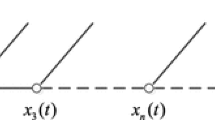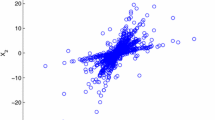Abstract
This paper considers the complex mixing matrix estimation in the under-determined blind source separation. An effective estimation algorithm through detecting single source points contributed by only one source is proposed. First, the single source points are detected by utilizing the real and the imaginary components of the time–frequency coefficients of mixed signals. The algorithm is suitable for the case in which the mixing matrix is complex, while traditional algorithms usually estimate the real mixing matrix. Then, through modeling and calculating, the mixing matrix of mixed signals can be estimated. Finally, the clustering process is improved in order to get more accurate results. The algorithm can estimate the complex mixing matrix when the number of sensors is less than that of sources. The experimental results validate the efficiency of the estimation algorithm.





Similar content being viewed by others
References
F. Abrard, Y. Deville, A time–frequency blind signal separation method applicable to under-determined mixtures of dependent sources. Signal Process. 85(7), 1389–1403 (2005)
S. Arberet, R. Gribonval, F. Bimbot, A robust method to count and locate audio sources in a stereophonic linear instantaneous mixture. In: 6th International Conference on Independent Component Analysis and Blind Signal Separation, Charleston, America (2006), pp. 536–543
S. Arberet, R. Gribonval, F. Bimbot, A robust method to count and locate audio sources in a multichannel underdetermined mixture. IEEE Trans. Signal Process. 58(1), 121–133 (2010)
P. Bofill, M. Zibulevsky, Underdetermined blind source separation using sparse representation. Signal Process. 81(11), 2353–2362 (2001)
F. Castell, J.J. Rieta, J. Millet et al., Spatiotemporal blind source separation approach to atrial activity estimation in atrial tachyarrhythmias. IEEE Tans. Biomed. Eng. 52(2), 258–267 (2005)
M. Cobos, J.J. Lopez, Two-microphone separation of speech mixtures based on interclass variance maximization. J. Acoust. Soc. Am. 127(3), 1661–1672 (2010)
T. Dong, Y. Lei, J. Yang, An algorithm for under-determined mixing matrix estimation. Neurocomputing 104(15), 26–34 (2013)
P. Georgiev, F. Theis, A. Cichocki, Sparse component analysis and blind source separation of underdetermined mixtures. IEEE Trans. Neural Netw. 16(4), 992–996 (2005)
Y. Guo, S. Huang, Y. Li, Single-mixture source separation using dimensionality reduction of ensemble empirical mode decomposition and independent component analysis. Circuits Syst. Signal Process. 1(6), 2047–2060 (2012)
K.T. Herring, A.V. Mueller, D.H. Staelin, Blind separation of noisy multivariate second-order statistics: remote sensing applications. IEEE Trans. Geosci. Remote Sens. 47(10), 3406–3415 (2009)
J. Huang, H. Pan, S. Bi, Application of particle swarm optimization blind source separation technology in fault diagnosis of gearbox. J. Cent. South Univ. Technol. 15(2), 409–415 (2008)
A. Hyvarinen, Testing the ICA mixing matrix based on inter-subject or inter-session consistency. NeuroImage 58(1), 122–136 (2011)
S.G. Kim, C.D. Yoo, Under-determined blind source separation based on subspace representation. IEEE Trans. Signal Process. 57(7), 2604–2614 (2009)
K. Liu, L. Du, J. Wang, Underdetermined blind source separation based on single dominant source areas. Sci. China Ser. E Inf. Sci. 38(8), 1284–1301 (2008)
G.R. Naik, D.K. Kumar, Determining number of independent sources in under-complete mixture. EURASIP J. Adv. Signal Process. Article ID 694850 (2009)
G.R. Naik, D.K. Kumar, An overview of independent component analysis and its applications. Int. J. Comput. Inf. 35(1), 63–81 (2011)
G.R. Naik, D.K. Kumar, Dimensional reduction using blind source separation for identifying sources. Int. J. Innov. Comput. Inf. Control 7(2), 989–1000 (2011)
M. Puigt, Y. Deville, Time-frequency ratio-based blind separation methods for attenuated and time-delayed sources. Mech. Syst. Signal Process. 19(6), 1348–1379 (2005)
G. Qian, L. Li, M. Luo, On the blind channel identifiability of MIMO–STBC systems using non-circular complex FastICA algorithm. Circuits Syst. Signal Process. 33(6), 1859–1881 (2014)
V.G. Reju, S.N. Koh, I.Y. Soon, An algorithm for mixing matrix estimation in instantaneous blind source separation. Signal Process. 89(9), 1762–1773 (2009)
J.J. Thiagarajan, K.N. Ramamurthy, A. Spanias, Mixing matrix estimation using discriminative clustering for blind source separation. Digital Signal Process. 23(1), 9–18 (2013)
Y. Wang, Spatial Spectral Estimation Theory and Algorithm (Tsinghua University Press, Beijing, 2004)
M. Xiao, S. Xie, Y. Fu, Undetermined blind delayed source separation based on single source intervals in frequency domain. Acta Electr. Sin. 35(12), 2367–2373 (2007)
J. Xu, X. Yun, D. Hu et al., A fast mixing matrix estimation method in the wavelet domain. Signal Process. 95, 58–66 (2014)
O. Yilmaz, S. Rickard, Blind separation of speech mixture via time–frequency masking. IEEE Trans. Signal Process. 52(7), 1830–1847 (2004)
X. Yu, T. Cao, D. Hu et al., Blind image separation based on wavelet transformation and sparse component analysis. J. Beijing Univ. Posts Telecommun. 33(2), 58–63 (2010)
X. Yu, J. Xu, D. Hu et al., A new blind image source separation algorithm based on feedback sparse component analysis. Signal Process. 93(1), 288–296 (2013)
G. Zhou, Z. Yang, S. Xie et al., Mixing matrix estimation from sparse mixtures with unknown number of sources. IEEE Trans. Neural Netw. 22(2), 211–221 (2011)
Acknowledgments
This work is supported by the Nation Nature Science Foundation of China (Nos. 61301095 and 51374099), the Fundamental Research Funds for the Central Universities of China (No. HEUCF140807), the Heilongjiang Province Natural Science Foundation (No. F201345) and the Heilongjiang Province Natural Science Foundation for the Youth (No. QC2012C070).
Author information
Authors and Affiliations
Corresponding author
Rights and permissions
About this article
Cite this article
Li, Y., Nie, W. & Ye, F. A Complex Mixing Matrix Estimation Algorithm Based on Single Source Points. Circuits Syst Signal Process 34, 3709–3723 (2015). https://doi.org/10.1007/s00034-015-0027-3
Received:
Revised:
Accepted:
Published:
Issue Date:
DOI: https://doi.org/10.1007/s00034-015-0027-3




